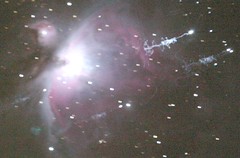I searched the web for such a program, but came up short. What is needed is the ability to take two images, taken on different nights maybe with different instruments. Orientations and scale might vary. It's quite labor intensive to resize and rotate the two images by hand. Below is what I came up with (see Related links, below)
S.B.I.G. CCDBLINK Software: Allows blink comparison with ST-4 images on PC - will it auto-rotate? $99.00
-------------
MaxIm DL allows blink comparison of two images of the same stellar field. Once the two images are aligned and the intensities are matched correctly, any new or changed object shows up as a blinking object when the two images are swapped rapidly. - What a big nothing!
-------------
- Graphical Astronomy and Image Analysis Tool ( GAIA )
- GAIA is a graphical image display and analysis tool, it provides the usual facilities of image display tools, plus more astronomically useful ones such as aperture photometry, arbitrary region analysis, celestial co-ordinate readout, calibration and modification, grid overlays, blink comparison, defect patching and the ability to query on-line (WWW) catalogues.
- .... "Celestial co-ordinates readout." ... under "Image Analysis Capabilities"
GAIA now offers two new toolboxes based on the Starlink AUTOASTROM program. These make it possible to provide a minimum of positional information (image centre and scale) and then fit an astrometric solution. They also make it possible, for the first time, to fit optical distortions.
The blink comparison toolbox has been substantially upgraded in this release. New features are options to alignment to NDF origins or FITS CRPIX values. This gives much better behaviour when comparing images of different dimensions. Better performance (less flickering artifacts). The ability to drag images and enter image coordinate offsets. All images can now be viewed together or one-by-one as before. Images should now always scroll and the "Refresh" button has been removed.
------------
A related subject: Determining coordinates - no easy way found, see http://groups.google.com/group/sci.astro.fits/browse_frm/thread/105fe7913d387aa5/c70cf7ece67e1a8a?lnk=st&q=%22determining+coordinates%22+astronomy&rnum=1&hl=en#c70cf7ece67e1a8a
Related links -
Image Processing Resources for Astronomy Teachers http://www.phy.duke.edu/%7Ekolena/imagepro.
Astrometrica is a interactive software tool - html#ipAstrometrica is a interactive software tool
-------------------
'CHARON' ASTROMETRIC SOFTWARE
With Charon, one must provide an image, specifying either the object or an approximate position in the sky. Charon will then examine the image you've taken, and will search through a star catalog (such as the GSC and Tycho databases on the Guide CD-ROM) for stars covering that area. It then will calculate the transformation between J2000 RA/dec and positions in the image.
Once it has done this, it has registered the image to the sky, and will show you the image with GSC stars superimposed as an overlay. You can move the cursor around and collect information concerning the RA, declination and magnitude of objects in the image. You can hit Tab to immediately zoom in on the target object; Charon will show both the computed, "expected" position of the target object, as well as its actual observed position in the image, and the difference (observed - computed, or "O-C", or "residual") between them. http://www.projectpluto.com/charon.htm#description
